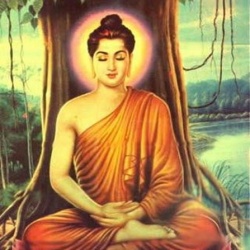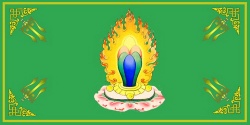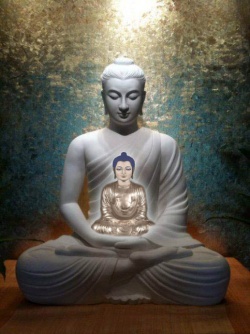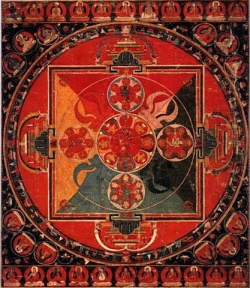Preparing for the Bardo
Thank you for showing this wonderful film on the bardo. It is good to see the visions of death and after death. So know we know the information, so what should we do next? All Buddhist practices direct us to our Buddha nature.
There are four different levels of tantra. Tantra means continuity, the continuity of our natural state.
This is called Buddha nature or dharmata. But how should we recognize it. If we don't have meditation experience in life we will be scared at the point of death. How should we handle that fear.
The Tibetan Book of the Dead explains this, as well as the other tantras. Tantra tells us what to practice before death. There are many deities to meditate on.
These deities are not external, they represent our natural state of mind. Vajrasattva is white. This symbolizes the purity of our mind. The deity is not flesh and bone, it is immaterial.
If you meditate on the deity often, you will see them at the point of death. For example, I used to live in Bishop California, near the mountains, so I think I will see mountains when I die. There are three types of yoga to practice. In Mahayoga tantra the deity is outside us.
The generation of the deity represents birth and the dissolution represents death and the mind experiencing the emptiness of the dharmakaya. It is very important to meditate on emptiness with a compassionate motivation.
That is why deities are visualized as they are. If you do this meditation several times a day you will experience the deity in your dreams. This is a sign of success of your deity yoga practice.
At the time of death, when the elements and thoughts dissolve, you will see the deity and recognize your natural state. You will have no fear at the time of death.
In anu yoga tantra you visualize yourself as the deity. The purpose is the same: to experience your natural state. It is closer to the truth than the maha yoga tantra.
The third practice is ati yoga tantra. If you are capable of it, you experience your buddha nature without the need for visualizing deities.
It includes mahamudra and dzogchen. Dzogchen has two sections, meditation on emptiness, and meditation on luminosity.
In one practice you visualize spheres of light reflected from the image of the sun. So there is no deity meditation. Instead you just sit and practice.
If you can do ati yoga, you don't need the lower tantras. But most people need to practice the lower tantras first. So why should we study all of them?
If you are willing to help sentient beings, you have to remove your mental obstacles through practice and you have to learn all the paths so you can guide others. The deity meditations are concordant with the three bodies of the deity: the dharmakaya sambhogakaya, and nirmanakaya.
Dream yoga and other practices are concordant with the sambhogakaya. Meditation on emptiness is concordant to the dharmakaya. The generation stage practice is concordant with the nirmanakaya. So this is what tantra explains.
There are six bardos, or intermediate states. This life is one bardo. The process of dying is another bardo. When your consciousness leaves the body, that is another bardo.
There is the dream state, which is another bardo. Then there is the bardo of meditation. In deep meditation you are in another world.
When you practice don't just aim for heaven. Heaven is boring. If you have questions, please ask them.
Q: If you meditate a lot will your experience be different in the bardo?
A: If you meditate on emptiness and discover what it means, ego grasping will dissipate. It similar to clouds dispersing and seeing the blue sky. Why you lose that, you will get closer to the dharmata.
You will see in the bardo what you practice in this life. If you meditate in the bardo, your meditation will be stronger.
The disturbing emotions will not be there, so your practice will be stronger.
Q: If you are enlightened do you carry karma from past lives into the next?
A: Completely enlightened beings don't go through the bardo. The alaya consciousness contains the seeds of our karmic tendencies, like footprints in the snow.
If you are compassionate in this life and have good thoughts, your next life will be more fortunate. The karmic tendencies do not disappear even after a hundred thousand years.
We are reborn as a result of our ego clinging. The hands on a clock turn because of its motor. Similarly the energy of our ego clinging drives us about. Even positive motivations, such as the desire to meditate must be overcome.
Q: Is it customary to read the Bardo Thodol for every dying person in Tibet?
A: No, only certain persons have it read. If a person trusts a lama there is a connection there that allows the lama to help them.
Q: Is it good to do phowa practice at the time of death?
A: Oh, yes. In Tibetan phowa means transformation. All tantric practices all phowa in this sense.
Q: Should we extend our compassion to animals to have them evolve to higher consciousness?o read the Bardo Thodol for every dying person in Tibet?
A: Yes, but it is a little hard. You can recite mantras like "om mani padme hum."
The prayer wheels in the video contained this mantra. The six syllable mantra is easy to begin practicing. In Tibet the children learn it from listening to their parents. In the middle it does not give rise to pride.
And finally you will not forget it. You may forget your scholarship, but you won't forget this mantra. This mantra has many explanations.
The syllable "om" is made from three letters (a, u, and m). These symbolize the enlightened qualities of body speech and mind.
The syllable "mani" means jewel.
It symbolizes compassion. You need compassion to achieve "om", the enlightened state. The syllable "padme" means lotus.
It symbolizes wisdom. The lotus is born in dirty water but remains pure. Wisdom is the remedy for negative thoughts.
The union of wisdom and compassion form the full Buddhist path. The syllable "hung" symbolizes union. Wisdom and compassion should not remain separate.
They must be combined. So the whole Buddhist path is contained in this mantra.
So if you are not interested in the complexities of scholarship, they are all contained in this simple practice. If you practice this regularly, you will see Avalokiteshvara at the point of death or in the bardo. The syllable "hrih" represents the mind of Avalokiteshvara.
You need the union of wisdom and compassion for enlightenment. When you get angry, think that is not what you should be doing. If you cultivate a compassionate attitude, that will slowly bring peace.






